The Autonomic Nervous System: An overview of how the body maintains balance +VIDEO {Lifestyle Medicine}
The Autonomic Nervous System: An overview of how the body maintains balance
{Lifestyle Medicine}
The autonomic nervous system (ANS) works largely autonomously, without your conscious effort to control the “automatic” functions of the body that you do not consciously think about, such as heart rate, blood pressure, digestion, dilation and constriction of the pupils of the eyes, kidney function, and temperature control.
Subscribe to my YouTube Channel for more healthy recipes, lifestyle tips and more!
Affiliate Disclosure & Privacy Policy (please review our complete policy here): we use affiliate links and analytics on our website, social media posts and newsletter which utilize cookies placed on your browser to track sales activity. This post is NOT sponsored. When you click an affiliate link on our Website, a cookie on your browser tracks sales activity. When you click these links and purchase a product, we may receive a small commission to help support the maintenance of our website, but the price is the same for you. Users can control the use of cookies at the individual browser level. Please review our complete privacy policy here. Thank you for your support! These statements have not been evaluated by the FDA and should not be considered medical advice or treatment. Please consult your personal health provider before making any changes to your diet or lifestyle.
This post is part 1 of a series. For more about What Happens When the Autonomic Nervous System Dysfunction and Dysauotnomia check out part 2 here and the Survival Kit for Dysautonomia Management in part 3 here!
Overview of the Autonomic Nervous System
The autonomic nervous system (ANS) receives input from parts of the central nervous system that process and integrate stimuli from the body and external environment and contribute signals and outputs that help the body maintain balance and normal homeostatic function. The ANS influences the entire body including blood vessels, internal organs (stomach, intestines, liver, kidneys, bladder, genitals, lungs, heart), pupils and sweat, salivary and digestive glands.
The ANS consists of:
- somatic afferent (inward conducting) pathways which contain sensory nerve fibers which conduct impulses of pain, touch and temperature from the surface of the body to the spinal cord and impulses of muscle sense, tendon sense and joint sense from deeper structures;
- the central nervous system (brain and spinal cord) which integrate signals and inputs; and
- two efferent (outward conducting) limbs, the sympathetic and the parasympathetic nervous systems, which carry nerve impulses away from the central nervous system toward the peripheral effector organs such as muscles and glands (Hall, 1990).
How the Body Maintains Balance: The Autonomic Nervous System
The aim of the autonomic nervous system is to maintain homeostasis of internal organs, glands and small muscles to coordinate automatic physiologic processes which maintain many important functions within the body. The autonomic nervous system uses many internal automatic regulators that act like thermostats to maintain a fairly steady state in the inner processes of the body.
Most autonomic functions are involuntary, but they can often work in conjunction with the somatic nervous system which provides voluntary control.
The various components of the ANS control functions such as:
- blood pressure
- heart rate
- circulation
- temperature regulation and perspiration
- breathing and respiration
- metabolism
- cognition and short-term memory
- digestion and excretion (urination, defection, perspiration)
- the balance of water and electrolytes like sodium, calcium and potassium
- interpretation of external sensory stimuli
- adapting to an upright physical position (orthostasis)
- pain perception and processing
- sexual responses
- regulation of sleep and wake cycles

The Sympathetic, Parasympathetic and Enteric Branches of the Autonomic Nervous System
There are three main components of the efferent/outward acting limbs of the ANS: sympathetic, parasympathetic and enteric. Overall, the divisions of the autonomic nervous system work together to ensure that the body responds appropriately to different situations.
The Sympathetic Branch of the Autonomic Nervous System

The sympathetic branch of the ANS is responsible for preparing the body for the demands and stress of daily life and responding to emergencies, giving it the nickname the “flight or fight” response. It stimulates vital organs and glands to trigger responses such as:
- increased heart rate and contractility of cardiac cells,
- increased oxygenation with dilated bronchioles of the lung,
- dilation of pupils to allow more light to enter the eyes,
- increased blood flow to skeletal muscles, cardiac muscle and the lungs,
- perspiration and
- the release stored energy.
- Conversely, the sympathetic response slows body processes, constricts intestinal and urinary sphincters and diverts blood flow away from functions that are less important in emergencies, such as digestion and urination.
Norepinephrine/noradrenaline is the primary chemical neurotransmitter at sympathetic nerve endings.
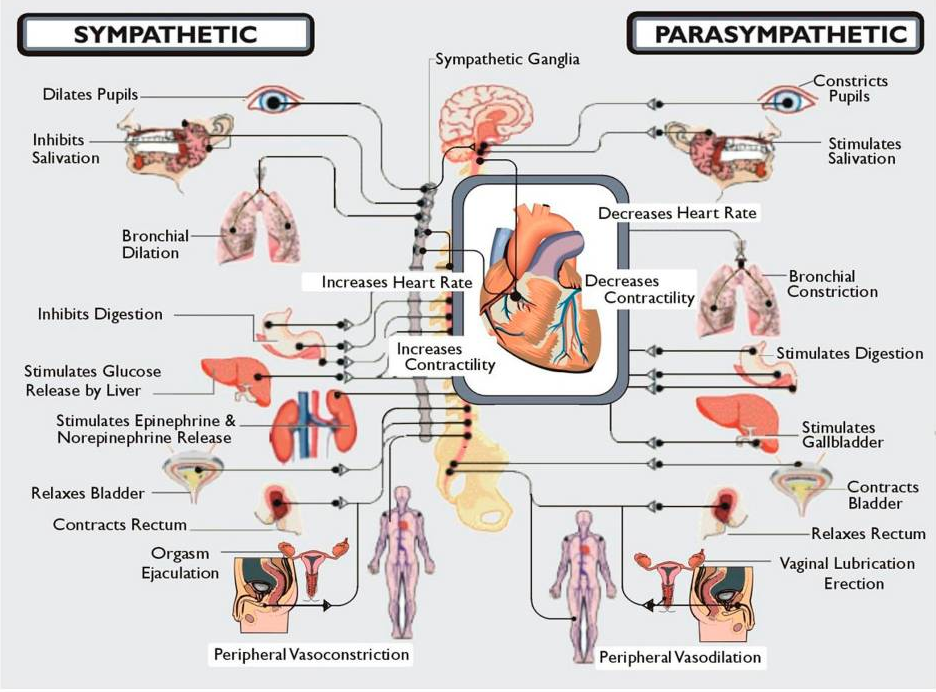
Copyright (c) 2012 Vinik.
The Parasympathetic Branch of the Autonomic Nervous System
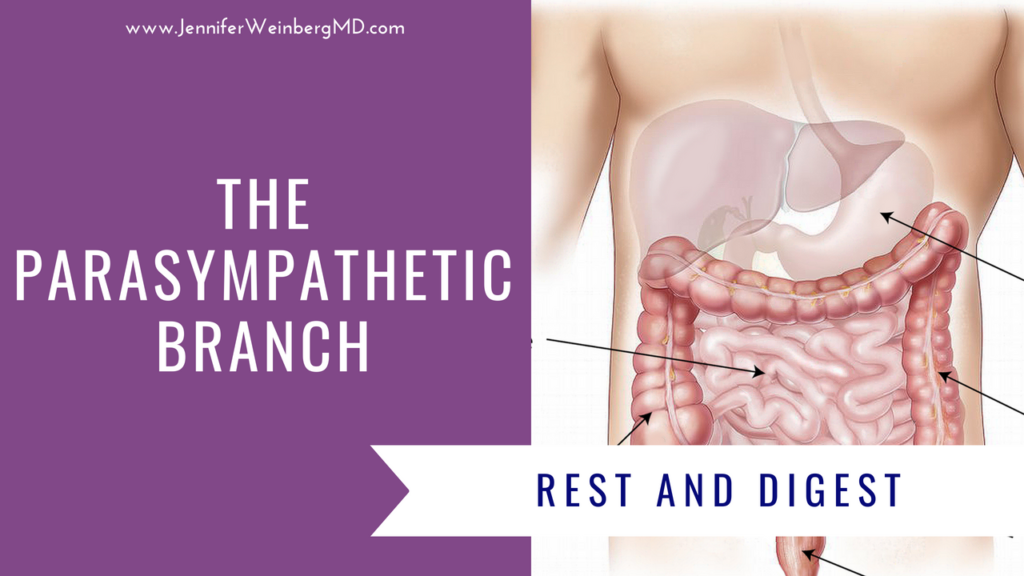
The parasympathetic branch of the ANS is known as the “rest and digest” response since slows down the body to focus on rest, restoring and digestion. The parasympathetic branch stimulates the digestive tract to process food and eliminate wastes so that this energy can be used to restore and build tissues.
Under ordinary situations when the parasympathetic system is dominant, the body focuses on processes that allow restoration and healing of the body to occur including:
- releasing digestive enzymes and stimulating salivary gland secretion,
- slowing heart rate,
- decreasing blood pressure,
- constriction of the pupils,
- dilating blood vessels leading to the digestive tract and
- constricting brochiolar diameter when the need for oxygen is decreased.
Acetylcholine is the primary chemical neurotransmitter at parasympathetic nerve endings.
The Enteric Branch of the Autonomic Nervous System
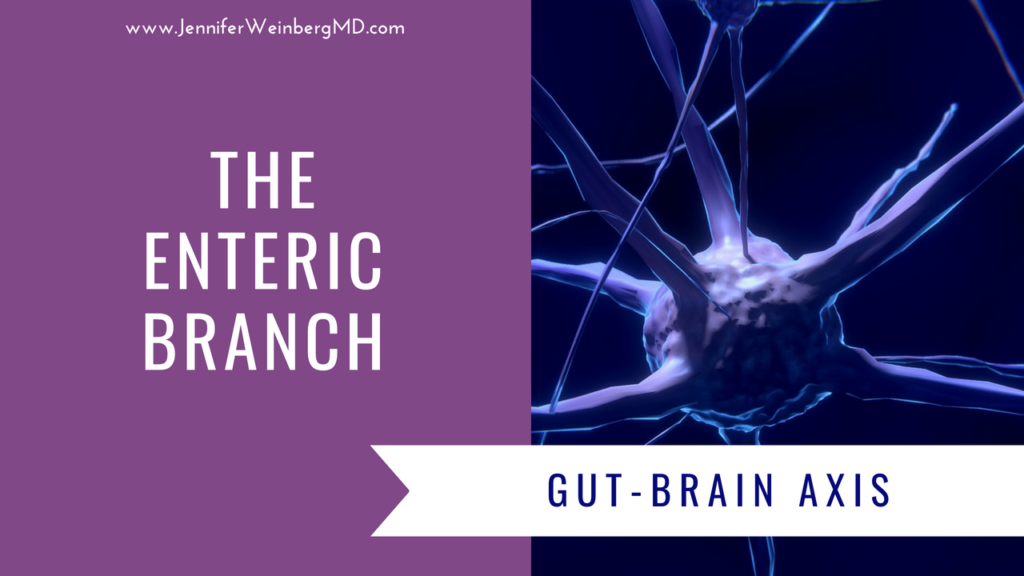
The enteric (gastrointestinal) part of the ANS is responsible for functions of the gastrointestinal system including motility, absorption of micronutrients and the release of chemical messengers. This underlies the powerful gut-brain connection.
Functions of the enteric nervous system include:
- sensing chemical and mechanical changes in the gut,
- regulating secretions in the gut,
- controlling peristalsis and movement in the gastrointestinal tract.
Balancing the Autonomic Nervous System
Most organs receive parasympathetic supply by the vagus nerve and sympathetic supply by splanchnic nerves. In addition to excitatory and inhibitory synapses, a further subsystem of neurons and neurotransmitters have been identified known as non-noradrenergic, non-cholinergic transmitters because they use nitric oxide as a neurotransmitter. This subsystem plays an integral role in autonomic function, in particular in the gut and the lungs (Belvisi, Stretton, Magdi & Barnes, 1992).
When the autonomic nervous system is working correctly, there is a balance between these branches, and formal functioning of the digestion, cardiovascular, respiratory and hormonal systems can occur. When this balance is not working properly, the inner world of the body is not able to maintain homeostasis or normal responses to demands and dysautonomia can result.
The Autonomic Nervous System (ANS) and Immune Responses
The brain and the immune system are hardwired through the autonomic nervous system. The sympathetic nervous system richly innervates all lymphoid tissues, including bone marrow, thymus, spleen, mucosal-associated lymphoid tissues, and lymph nodes (Bellinger, Millar, Perez, et al., 2008).
The sympathetic nervous system plays a key role in modulating inflammatory processes (Hasko & Szabo, 1998) with pro- or anti-inflammatory functions depending on factors such as neurotransmitter concentration, receptor affinity, timing of autonomic nervous system activity in relation to the inflammation course, and more (Straub, Wiest, Strauch, Harle & Scholmerich, 2006) along with modulation by adrenergic neurotransmitters released by the adrenal glands (Hasko & Szabo, 1998).
While less well understood, the parasympathetic branch of the nervous system also modulates inflammation especially via the anti-inflammatory role of vagal acetylcholine known as the “cholinergic anti-inflammatory pathway” (Borovikova, Ivanova, Zhang et al., 2000). These pathways play a role in animal models of pancreatitis, inflammatory bowel disease, postoperative ileus, lethal endotoxemia, and hemorrhagic shock.
In this way, inflammatory processes convey information to the central nervous system which, in turn, sends information back to the site of inflammation via neural mediators which are influenced by the autonomic nervous system.
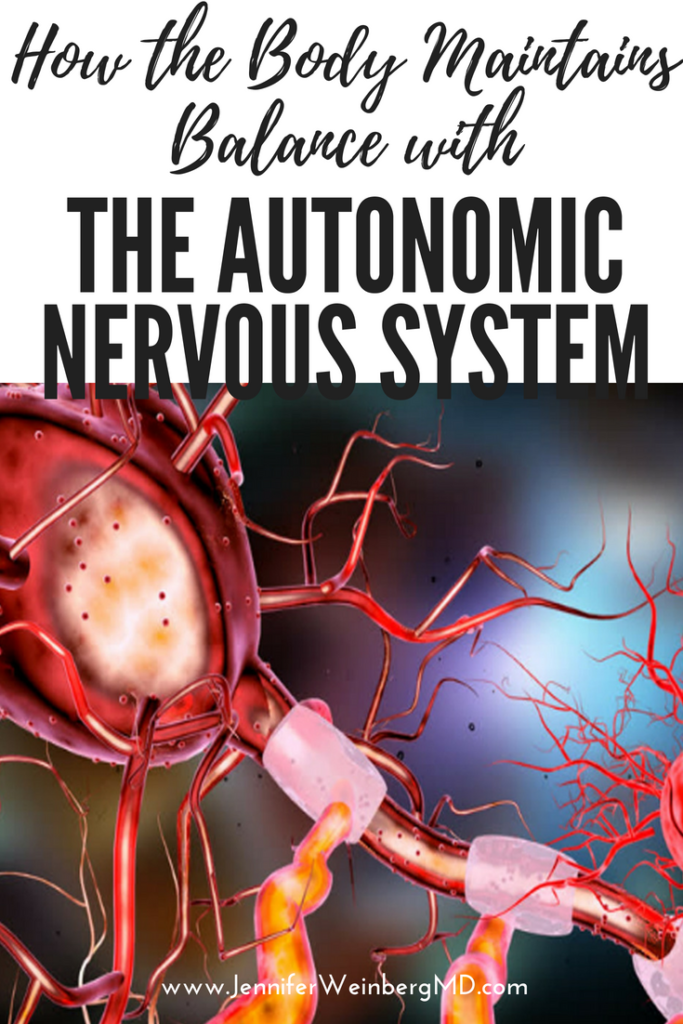
References:
Bellinger D.L.,Millar B.A., Perez S. et al. (2008). Sympathetic modulation of immunity: relevance to disease. Cellular Immunology, 252(1-2): pp. 27–56.
Belvisi, Stretton, Magdi & Barnes (1992). Nitric oxide is the endogenous neurotransmitter of bronchodilator nerves in humans. European Journal of Pharmacology, 210 (2): 221–2.
Borovikova L.V., Ivanova S., Zhang M., et al. (2000). Vagus nerve stimulation attenuates the systemic inflammatory response to endotoxin. Nature, 405(6785): 458–462.
Haskó G. & Szabó C. (1998). Regulation of cytokine and chemokine production by transmitters and co-transmitters of the autonomic nervous system. Biochemical Pharmacology, 56(9:) pp. 1079–1087.
Straub R., Wiest R,. Strauch U.G., Härle P., & Schölmerich J. (2006). The role of the sympathetic nervous system in intestinal inflammation. Gut, 55(11):1640–1649.
I would love to have you in my Insider’s Community! Join for free and receive your FREE Chapters from The Whole Cure: 52 Essential Prescriptions to Overcome Overwhelm, Reclaim Balance and Reconnect with a Life You Love! You can pick up a full paperback or Kindle copy on Amazon for a wealth of insights, exercises and complete toolkit to help you uncover your true passions, authentic purpose and calm confidence as well!
To keep building your healthy lifestyle and best self through everyday habits, take the next step today to commit to a life you truly love and feel fully alive!
-
Pick up a copy of The Whole Cure to build resilience and manage stress in a way that makes life flow with greater ease and joy!
-
Access guided relaxation exercises utilizing the power of the breath and mind here.
-
Join my next online group Whole Cure Lifestyle Transformation Programs to build more powerful coping strategies and skills for meaningful stress management and a calmer life! Contact me to form your own guided online group or register for the next scheduled online program!
Medical Disclaimer: Information provided in this post and related resources are for informational purposes only. Jennifer Weinberg is not providing medical advice, diagnosis or treatment information. The information is NOT a substitute for the advice provided by your physician or other healthcare professional. Every body is unique. Be sure to check with your healthcare professional before making any dietary or lifestyle changes, taking any medication or nutritional supplement or using any treatment for a health issue. Do not use this information provided for diagnosing or treating a health problem or disease. If you suspect you have a medical problem please contact your healthcare provider promptly and do not disregard professional medical advice based on anything on this website. This website and related resources are not intended to diagnose, treat, cure or prevent disease and do not create a doctor-patient relationship between you and Jennifer Weinberg. These statements are not evaluated by the FDA. These products are not intended to diagnose, treat, cure, or prevent any disease.
This post is shared with: Healthy Happy Living Link Party, Home Matters Link Party, Saturday SITS Sharefest


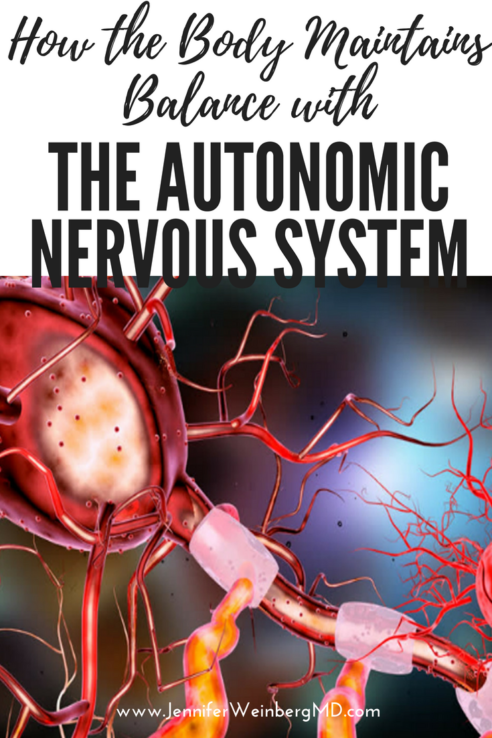

Comments